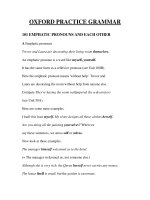101 COMPARISON CONTRAST 2010
Bạn đang xem bản rút gọn của tài liệu. Xem và tải ngay bản đầy đủ của tài liệu tại đây (3.28 MB, 79 trang )
COMPARISON
or
CONTRAST
ESSAY
2
PREWRITING
3
PREWRITING
o Decide upon which side of the coin you will
focus.
o That is, decide whether you will
compare OR contrast your subjects.
4
COMPARISON
SIMILARITIES
/ DIFFERENCES
5
CONTRAST
DIFFERENCES
ONLY
6
DO NOT DO BOTH!
* NOT
both COMPARE and CONTRAST
7
PREWRITING
* SUBJECTS:
o only 2
o choose subjects from the
same general category
not apples vs. car:
o not note 8 vs. milk tea
o
=
* POINTS of COMPARISON/CONTRAST:
o 3 points of comparison/contrast
o compare or contrast the same 3 points
for each subject
8
PREWRITING
(1) Choose between comparison OR
contrast.
(2) Select 2 subjects from the same
general category.
(3) Brainstorm points of comparison and/or
contrast.
(4) Choose the 3 most significant points of
comparison or contrast to be utilized
throughout the essay.
(5) Draft a detailed outline of this essay
following one of the organizational
schemes discussed below.
9
INTRODUCTIO
N
10
INTRODUCTION
o First, as always, introduce your topic or broad
category and identify your audience and
purpose:
11
INTRODUCTION
(1) GENERALIZATION:
o Write a generalization that introduces your general
category.
o “Everybody,” “Most people”
o For example, if you are contrasting two specific cars,
generalize about vehicles:
Most college students need some kind of vehicle to get
to class and work.
o If you are comparing two tragic events, generalize
about history or epochal moments.
12
INTRODUCTION
(2) SCENARIO:
o Create one as you did in the Process essay.
o Create a situation in which this comparison or
contrast is relevant or necessary.
o For example, if you are contrasting 2 cars,
discuss your personal experience in which
you traded in your “Junk Mobile” for
something respectable.
13
INTRODUCTION
o Next, narrow the broad category
(that you mentioned in your opening
generalization) towards the two
specific subjects that you will compare
or contrast:
“Some” and “Others”
If you generalized about vehicles, perhaps
move to types of vehicles (using
Classification).
Some of us drive “big ol’ trucks,” while others
drive little “gas misers.”
14
INTRODUCTION
o Now you should be at that spot to announce
your two subjects.
Segue from your previous statement:
However, the most common type of car I have
noticed in the school parking lot is the midsized sedan, and the two most popular models
are the Honda Accord and the Toyota Camry.
15
INTRODUCTION
o At this point, you have introduced your
general topic/category, identified your
audience, and announced your subjects.
o Now, you must now set up your contrast or
comparison.
o Now it is time to “tip your hat.”
16
INTRODUCTION:
Tip o’ th’ Hat #1
o First, tip your hat to the other
side of the coin (if you’ll forgive the
mixed metaphor).
o That is, mention the opposite aspect briefly.
This allows you to segue to your three
main points of comparison or contrast.
This establishes your ethos (credibility) as
a writer.
These ubiquitous models share
similarities, such as available colors
and tire covers.
17
INTRODUCTION:
Tip o’ th’ Hat #1
o Thus, if you are writing a contrast
essay, admit that similarities exist
and list a few of them.
o If, on the other hand, you are writing a
comparison essay, admit that differences exist
and mention a few.
o
o
Contrast Essay: admit the similarities
Comparison Essay: admit the differences
18
INTRODUCTION:
Tip o’ th’ Hat #1
o Now, you need to segue from the
opposite side of the coin (the
opposite aspect that you mentioned
in the previous statement) to the one
you will focus on in the Body of your essay.
19
INTRODUCTION:
Tip o’ th’ Hat #1
o To do this,
(1) state that your approach has
more significant or important
differences/similarities:
That is, in a comparison essay, state that the
similarities are more important.
In a contrast essay, state that the differences
are more important.
However, despite these minor similarities, the
differences between the Accord and Camry are
more significant.
20
INTRODUCTION:
Tip o’ th’ Hat #1
(2) tip your hat to the minor points:
Because you cannot discuss ALL
differences or ALL similarities in the
Body of your essay,
admit the limits of your contrast or comparison
by listing here the other—less significant or too
obvious—differences or similarities.
21
INTRODUCTION:
Tip o’ th’ Hat #1
Thus, in a contrast essay, mention
some of the other differences.
In a comparison essay, list some of
the other similarities.
These points will not be in the Body.
These points did not “make the cut.”
Some of these dissimilarities include the
exhaust, sound, and fuel systems.
22
INTRODUCTION:
Thesis Statement
o At this point, you have introduced your
general category, identified your audience and
two subjects, and mentioned some similarities
and differences.
o Now you are ready to state your thesis.
23
INTRODUCTION:
Thesis Statement
o Mention the 2 subjects.
o Mention the 3 points of comparison or
contrast.
Be
clear.
Be concise.
Be consistent (parallel structure).
24
INTRODUCTION:
Thesis Statement
o Answer this question: Why these 3?
o after “tipping your hat” to the other similarities
or differences, create your focus by stating that
these 3 = the superlative:
o most important, significant, relevant,
representative, fundamental, notable, …
However, the most important similarities shared
by Subjects X and Y include 1, 2, and 3.
Nevertheless, the Honda Accord and Toyota
Camry differ significantly in terms of gas
mileage, engine size, and extras.
25
INTRODUCTION
I. Generalization
Types
2 subjects
Similarities (opposite)
Differences (minor points)
* Thesis (3 most significant points)









